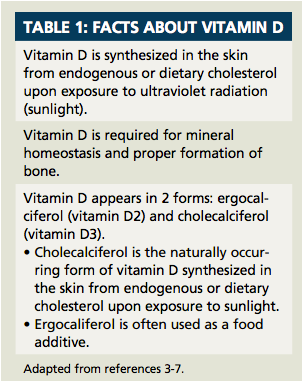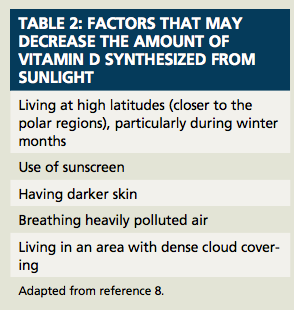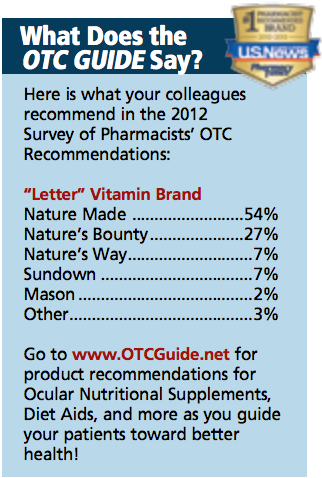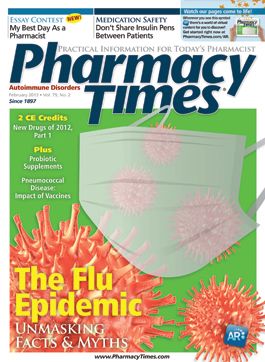Publication
Article
Pharmacy Times
Vitamin D: Are Your Patients Getting Enough?
Author(s):
As vitamin D deficiency gets more attention in the media, patients turn to supplements.
As vitamin D deficiency gets more attention in the media, patients turn to supplements.
Researchers regularly turn up new findings regarding the role played by vitamin D in overall health. As a result, interest in vitamin D supplementation has surged in recent years.
In the United States, the sale of vitamin D supplements increased from $42 million to $605 million between 2002 and 2011.1
Yet many individuals still suffer from low vitamin D levels. According to the Centers for Disease Control and Prevention, between 2001 and 2006, approximately two-thirds of the population had sufficient vitamin D levels, one-fourth were at risk of vitamin D inadequacy, and 8% were at risk of a vitamin D deficiency.2
Vitamin D is a fat-soluble vitamin whose primary biologic function is to maintain normal blood levels of calcium and phosphorus.3-5 It has properties of both a vitamin and a hormone. It aids in the absorption of calcium in the gut and assists in maintaining sufficient serum calcium and phosphorus levels to allow for normal mineralization of bones.3-7 Maintaining an adequate level of vitamin D helps decrease the risk of fractures from falls.3 Table 13-7 provides more interesting facts about vitamin D.

Different Patients, Different Needs
Most people obtain a sufficient amount of vitamin D through diet and exposure to sunlight. Some are at greater risk for vitamin D deficiencies, however, especially during the winter months, when sun exposure is limited (Table 28).3-5 Patient populations that may be at elevated risk for vitamin D deficiencies include the elderly, obese individuals, exclusively breast-fed infants, and those who have limited sun exposure.3-5
In addition, individuals who have fat malabsorption syndromes, such as cystic fibrosis or inflammatory bowel disease, including Crohn’s disease, are at risk for vitamin D deficiency.3-5 The use of medications such as phenytoin and carbamazepine may increase the metabolism of vitamin D and reduce calcium absorption.3-5 On the other hand, patients taking corticosteroids may experience impaired metabolism of vitamin D and should be monitored for adequate vitamin D levels.3,6-8
Clinical studies have associated vitamin D deficiency with autoimmune disorders, cardiovascular disease, cancer, musculoskeletal decline, dementia, infectious disease, and depression.3,9 Table 310-14 outlines recent research on the impact of vitamin D on health.

RDA for Vitamin D
In recent years, there has been a great deal of debate about vitamin D supplementation and the proper recommended dietary allowance (RDA) for this vitamin. The Institute of Medicine (IOM) recommends an RDA of 400 IU of vitamin D for children younger than 1 year, 600 IU for those aged 1 to 70 years, and up to 800 IU for those 71 years and older.10,11
The IOM also recommends an upper limit of 4000 IU per day.
10,11
The IOM points out, however, that higher doses may be necessary for those with osteoporosis or vitamin D deficiency.10,11 The IOM has concluded that a vitamin D level of 20 ng/mL should be considered adequate and that the long-term safety and potential adverse effects of levels above 50 ng/mL is unknown, although emerging evidence suggests potential adverse effects at this level or higher.10,11
In May 2012, the US Preventive Services Task Force recommended supplementation of 800 IU of vitamin D per day for those at risk for falls or fractures.10,12 The Endocrine Society’s clinical practice guideline on vitamin D deficiency suggests that an RDA of 400 to 1000 IU may be needed for children 1 year and older and 1500 to 2000 IU may be required for those 19 years and older.10,12 The guidelines also state that current clinical evidence suggests that children and adults should maintain a vitamin D level of at least 20 ng/mL to prevent rickets and osteomalacia.10,12
The guidelines further state that in order to maximize vitamin D’s effect on calcium, bone, and muscle metabolism, the vitamin D level should be at least 30 ng/mL. Numerous epidemiologic studies have suggested that a vitamin D level of at least 30 ng/mL may also decrease the risk of type 2 diabetes and cardiovascular disease, as well as certain cancers, autoimmune diseases, and infectious diseases.11 In January 2011, the American Academy of Dermatology updated its position statement on vitamin D so that it was in agreement with the IOM’s recommendations.13
Vitamin D Supplements
Vitamin D supplements are available as single-entity products or as products that combine vitamin D with calcium; vitamin D is also included in many multivitamins. These supplements are available in dosage forms including liquid, capsules, tablets, and sublingual tablets to meet the needs of different patient populations.

Patients should be encouraged to consult with their primary health care provider prior to taking these supplement products because they may already be getting an adequate amount of vitamin D through diet, sun exposure, and multivitamin supplements containing vitamin D. When recommending vitamin D supplementation, vitamin D3, the natural form, is preferred over vitamin D2 because it is more effective at maintaining adequate levels in the human body.3-5
Patients suspected of having a nutritional deficiency should always be referred to their primary health care provider for further medical evaluation prior to recommending the use of these supplements. In addition, pharmacists are in a pivotal position to identify patients at risk for possible drug—nutrient interactions and should make clinical recommendations accordingly.
Counseling Points
During counseling, pharmacists should remind patients to adhere to recommended dosages unless otherwise directed by their primary health care provider. Patients should also be reminded to check the content of vitamin D in any other supplements that they may be taking to avoid possible toxicity, keeping in mind that the recommended daily upper limit for vitamin D is 4000 IU.3
Vitamin D toxicity is rare, but patients experiencing any of the signs associated with it should immediately consult their primary health care provider. These signs include weakness, anorexia, headache, somnolence, nausea, vomiting, dry mouth, a metallic taste, constipation, and muscle or bone pain.3,6,7 Vitamin D toxicity may also cause kidney stones, hypercalcemia, or renal failure.3,6,7 Patients should always be encouraged to discuss the use of vitamin D supplements with their primary health care provider to ascertain what is best for their individual health needs.
Ms. Terrie is a clinical pharmacy writer based in Haymarket, Virginia
References:
- Has Vitamin D been oversold? AARP website. www.aarp.org/health/drugs-supplements/info-07-2012/how-much-vitamin-d-is-enough.html. Accessed January 5, 2013.
- Vitamin D status: United States 2001-2006. Centers for Disease Control website. www.cdc.gov/nchs/data/databriefs/db59.htm#findings. Accessed January 5, 2013.
- Huckleberry Y, Rollins C. Essential and conditionally essential nutrients. In: Krinsky D, Berardi R, Ferreri S, et al, eds. Handbook of Nonprescription Drugs. 17th ed. Washington, DC: American Pharmacists Association; 2012.
- Vitamin D. Medline Plus website. www.nlm.nih.gov/medlineplus/druginfo/natural/patient-vitamind.html. Accessed February 18, 2013.
- Barclay L. Management of vitamin D deficiency reviewed. Medscape website. www.medscape.com/viewarticle/712007. Accessed January 8, 2013.
- Dietary supplement fact sheet: vitamin D. National Institutes of Health Office of Dietary Supplements. http://dietary-supplements.info.nih.gov/factsheets/vitamind.asp#h9. Accessed January 5, 2013.
- Vitamin D. Merck Manual for Healthcare Professionals Online Edition. www.merckmanuals.com/professional/nutritional_disorders/vitamin_deficiency_dependency_and_toxicity/vitamin_d.html. Accessed January 5, 2013.
- Vitamin D supplementation. Centers of Disease Control and Prevention website. www.cdc.gov/breastfeeding/recommendations/vitamin_d.htm. Accessed January 5, 2013.
- Haines ST, Park SK. Vitamin D supplementation: what’s known, what to do and what’s needed. Pharmacotherapy. 2012;32(4):354-382.
- Pramyothin P, Holock MF. Vitamin D supplementation: guidelines and evidence for subclinical deficiency. Curr Opin Gastroenterol. 2012;28(2).
- Dietary reference intakes for calcium and vitamin D. Institute of Medicine website. www.iom.edu/~/media/Files/Report%20Files/2010/Dietary-Reference-Intakes-for-Calcium-and-Vitamin-D/Vitamin%20D%20and%20Calcium%202010%20Report%20Brief.pdf. Accessed January 4, 2013.
- Evaluation, treatment and prevention of vitamin D deficiency clinical guidelines. The Endocrine Society website. www.endo-society.org/guidelines/final/upload/final-standalone-vitamin-d-guideline.pdf. Accessed January 4, 2013.
- Updated position statement on vitamin D. American Academy of Dermatology website. www.aad.org/stories-and-news/news-releases/academy-issues-updated-position-statement-on-vitamin-d. Accessed January 3, 2013.
- Vitamin D levels linked to daytime sleepiness. Medline Plus website. www.nlm.nih.gov/medlineplus/news/fullstory_132264.html. Accessed January 5, 2013.
- McCarty DE, Reddy A, Keigley Q, Kim PY, Marino AA. Vitamin D, race, and excessive daytime sleepiness. J Clin Sleep Med. 2012;8(6):693-697.
- Low vitamin D levels linked to more severe MS symptoms. John Hopkins news release website. www.hopkinsmedicine.org/news/media/releases/low_vitamin_d_levels_linked_to_more_severe_multiple_sclerosis_symptoms. Accessed January 5, 2013.
- Kjaergaard M, Eggen AE, Mathiesen EB, Jorde R. Association between headache and serum 25 hydroxyvitamin D [published online September 13, 2012]. Headache.
- McAlindon T, LaValley M, Schneider E, et al. Effect of vitamin D supplementation on progression of knee pain and cartilage volume loss in patients with symptomatic osteoarthritis. JAMA. 2013;309(2):155-162.







